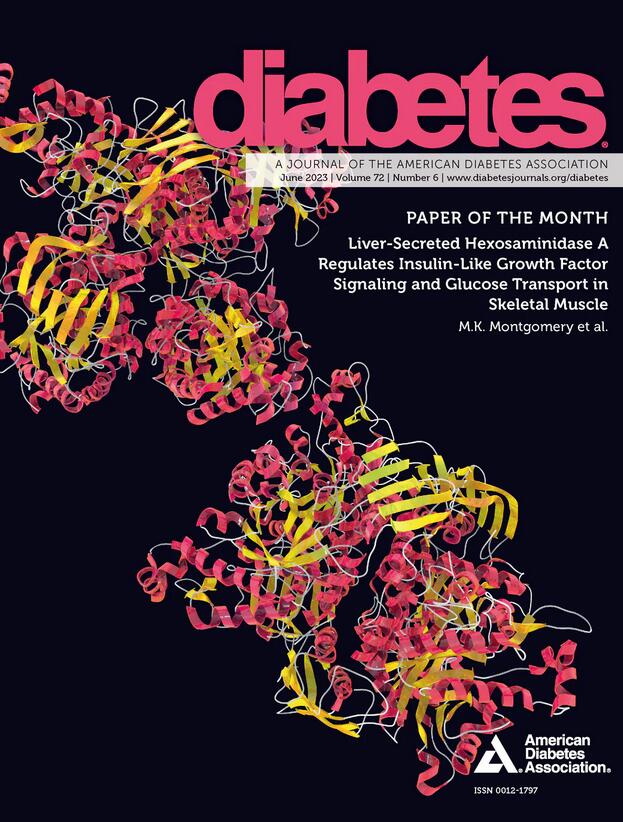349-OR:人胰岛中的 RNA 编辑酶 ADAR1 减少会引发干扰素反应并损害 Beta 细胞功能
IF 6.2
1区 医学
Q1 ENDOCRINOLOGY & METABOLISM
引用次数: 0
摘要
导言与目标:人们认为病毒感染会引发胰岛炎症、干扰素特征和自身免疫,从而导致 1 型糖尿病。尽管进行了大量研究,但仍未找到诱发病毒。我们假设,RNA 编辑功能受损和双链 RNA 在 beta 细胞中的积累会引发干扰素反应,导致胰岛炎症、自身免疫和 beta 细胞破坏。虽然在一些器官和癌症中研究了由作用于 RNA 的腺苷脱氨酶(ADAR)调控的 RNA 编辑,但对 ADAR 在人类胰岛中的作用却知之甚少。方法:为了阐明 ADAR1 在人胰岛中的作用,我们首先研究了 ADAR 在人胰岛中的表达和分布,研究时间跨越了人出生后的发育时间线(1 天、4 个月、2、6、10、35 年)。然后,我们用针对 ADAR 的 shRNA 转导了人假性小胰岛,并研究了它们的功能和基因表达。我们还将转导的假小体移植到 NSG 小鼠体内。对胰岛素分泌进行了测量,并对移植物进行了研究。结果:我们发现,在所有年龄段,ADAR1 在内分泌细胞中的表达均高于在尖突细胞中的表达。使用 shRNA 方法,ADAR mRNA 水平降低了 70%(n=11 供体)。培养7天后,dsRNA传感器、IFNB1、IRF7、IRF9和干扰素刺激基因的表达增加,而ADAR基因敲除的胰岛细胞中INS和MAFA的表达减少,但胰岛素分泌没有变化。然而,移植后 3 周,与乱码 shRNA 对照移植相比,使用 ADAR shRNA 移植的小鼠葡萄糖/精氨酸刺激的人胰岛素分泌明显减少(0.117 vs 0.300 ng/mL,p=0.0001,n=3 供体)。移植 4 周后对假性小鼠移植物的分析显示,ADAR 敲除的小鼠胰岛移植物周围有明显的小鼠 CD45+ 细胞聚集。结论人胰岛中 RNA 编辑的中断会激活干扰素信号通路,导致胰岛炎症和 beta 细胞功能障碍。披露 C. Dai:无。A.K. Singh:无。R. Brantley:无。A. Bradley:无。R. Jenkins:无。D.C. Saunders:无。M. Brissova:无。E. Levanon:顾问小组;ADARX、Exsilio。A. Klochendler:无:无。Y. Dor:无。A.C. Powers:无。本文章由计算机程序翻译,如有差异,请以英文原文为准。
349-OR: Reduction of RNA-Editing Enzyme ADAR1 in Human Islets Triggers an Interferon Response and Impairs Beta-Cell Function
Introduction & Objective: It is thought that viral infection triggers islet inflammation, an interferon signature, and autoimmunity resulting in type 1 diabetes. Despite extensive research, an inciting virus has not been identified. We hypothesized that impaired RNA editing and accumulation of double-stranded RNA in beta cells triggers an interferon response, causing islet inflammation, autoimmunity, and beta cell destruction. While RNA editing regulated by adenosine deaminases acting on RNA (ADAR) has been studied in some organs and in cancer, little is known about the role of ADAR in human islets. Method: To elucidate the role of ADAR1 in human islets, we first studied ADAR expression and distribution in human pancreas across postnatal developmental timeline (1 day, 4 months, 2, 6, 10, 35 years). Then we transduced human pseudoislets with a shRNA for ADAR and examined their function and gene expression. The transduced pseudoislets were also transplanted into NSG mice. Insulin secretion was measured and grafts were studied. Results: We found that ADAR1 expression at all ages was greater in endocrine cells than acinar cells. Using the shRNA approach, ADAR mRNA levels were reduced by 70% (n=11 donors). After 7-day culture, expression of dsRNA sensors, IFNB1, IRF7, IRF9, and interferon-stimulated genes was increased while INS and MAFA expression was reduced in ADAR knockdown islets without changes in insulin secretion. However, 3 weeks post transplantation, glucose/arginine-stimulated human insulin secretion was significantly decreased in mice with the ADAR shRNA graft compared with scrambled shRNA control graft (0.117 vs 0.300 ng/mL, p=0.0001, n=3 donors). Analysis of pseudoislet grafts 4 weeks after transplantation showed marked accumulation of mouse CD45+ cells around ADAR-knockdown islet grafts. Conclusion: Interruption of RNA editing in human islets activates the interferon signaling pathway leading to islet inflammation and beta cell dysfunction. Disclosure C. Dai: None. A.K. Singh: None. R. Brantley: None. A. Bradley: None. R. Jenkins: None. D.C. Saunders: None. M. Brissova: None. E. Levanon: Advisory Panel; ADARX, Exsilio. A. Klochendler: None. Y. Dor: None. A.C. Powers: None.
求助全文
通过发布文献求助,成功后即可免费获取论文全文。
去求助
来源期刊

Diabetes
医学-内分泌学与代谢
CiteScore
12.50
自引率
2.60%
发文量
1968
审稿时长
1 months
期刊介绍:
Diabetes is a scientific journal that publishes original research exploring the physiological and pathophysiological aspects of diabetes mellitus. We encourage submissions of manuscripts pertaining to laboratory, animal, or human research, covering a wide range of topics. Our primary focus is on investigative reports investigating various aspects such as the development and progression of diabetes, along with its associated complications. We also welcome studies delving into normal and pathological pancreatic islet function and intermediary metabolism, as well as exploring the mechanisms of drug and hormone action from a pharmacological perspective. Additionally, we encourage submissions that delve into the biochemical and molecular aspects of both normal and abnormal biological processes.
However, it is important to note that we do not publish studies relating to diabetes education or the application of accepted therapeutic and diagnostic approaches to patients with diabetes mellitus. Our aim is to provide a platform for research that contributes to advancing our understanding of the underlying mechanisms and processes of diabetes.
 求助内容:
求助内容: 应助结果提醒方式:
应助结果提醒方式:


